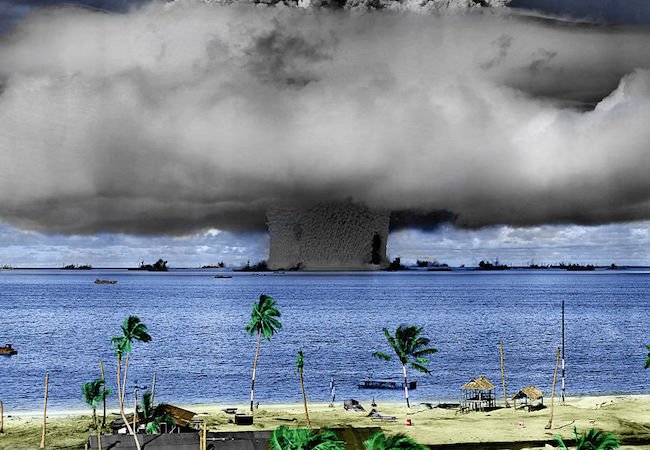
By Beenish Altaf
Theoretically, 1 July 2018 marked the 50thanniversary of the foundation of the Treaty on Nonproliferation of Nuclear Weapons (NPT) for signatures. Two schools of thought are prominent in explaining the emergence and evolution of the Nuclear Nonproliferation regime. One of them propagates this achievement as a sincere effort on the part of the major powers to curb the spread of nuclear weapons for a secure and peaceful world. Contending opinion explains it as a political move with implicit ambitions to sanction and secure the monopoly of major powers in this regard.
The NPT Review Conferences specifically the most recent being in May 2018 faced huge disappointment in showing up any positive outcome. It too ended up with nothing concrete in the sphere of non-proliferation regime. Likewise, the Nuclear Weapons States (NWS) are still not taking any substantial step / stance for Nuclear Disarmament (ND), which makes zero contribution to Article VI of Treaty. By what means can a settlement in presence for almost fifty years be judged as something besides a disappointment when one of its particular destinations, the end of atomic weapons, is much further away than in the season of its marking in 1968?
Since its inception, the Treaty has faced enormous challenges in securing its objectives. Ambiguity of its various clauses and discriminatory nature of its agenda has remained crucial in its failure to move towards non-proliferation and complete disarmament. NPT, as an instrument of eliminating nuclear weapons from this planet earth, does not have a well-connected, internally coherent mechanism to achieve the stated objective of arms control and disarmament. Adding to this, the text of this agreement provides for the serious rifts between its signatories and creates an unfavourable environment for the survival of the NPT. Furthermore, the question of haves and have-nots’ establishes the authority of some states and denies this privileged treatment to others. Based on these contradictions, its member states has clearly manipulated its existence for certain vested interests. The USA’s attempt to provide its NATO allies with nuclear technology and the recent nuclear deal between India (non-NPT state) and the US characterises a clear violation of provisions of the NPT.
Despite the fact that the indefinite extension of the NPT in 1995 reflects the strong commitment of member states to work on stated objectives, the treaty faces a bleak future. In a more recent event, in last review conference of 2015, committed signatory states were unsuccessful in reaching to an agreement / consensus. The divisive issue of complete nuclear disarmament between non-nuclear weapon states and nuclear weapons states has exposed the vulnerabilities of this regime.
According to the Stockholm International Peace Research Institute’s (SIPRI) yearly survey all the nuclear weapons powers, driven by Russia and the United States, are modernizing frameworks that will be effective by the 2040s. Analytically, the NPT is being utilized, not to advance nuclear disarmament, but somewhat to legitimize it. The NPT ought to be rejected and supplanted by a Comprehensive Disarmament Treaty (CDT) that revives the charter of the United Nation that was willingness and a desire for a world free of nuclear weapons and its threat of war.
During 1960-1970s both the USSR and the United States expected that their nuclear predominance was being diluted as nations outside their particular collusion structures, strikingly France and China, made nuclear bombs. Restricting the spread of atomic weapons was, in this manner, seen as commonly favourable. The inquiry was the manner by which to get guarantee from nations that were being requested to give up the nuclear choice.
Yet, numerous nations that upheld the guideline of non-proliferation had genuine reservations. As opposed to seeing the arrangement fall flat, the USSR and the United States concurred, at the later phases of the transactions, “to the consideration of Article VI requiring a cessation of the nuclear arms race at an early date and to nuclear disarmament.” But ironically there was no time-plan with respect to how this could be accomplished.
To end this deadlock and to achieve the desired objective of non-proliferation and complete disarmament, the NPT needs to revisit its long held agenda which is now becoming irrelevant in the face of much bigger challenge and changed realities. For this regime to be successful, all the established nuclear weapon countries, P-5 or more specifically signatories to the agreement, are required to take the lead by getting rid of their nuclear arsenals which would incentivise others to follow the suit. In addition to this, reservations of non-NPT nuclear weapon states, which have acquired nuclear weapons for certain security concerns, require immediate attention through the modification of the current NPT structure. Considering the failure of last held NPT review conference, the need is to change the traditional consensus based arrangement that has obstructed the progress over other areas of serious nature.
The desired objective of arms limitation and finally complete disarmament demands no less. This 50thanniversary reminds all nations, particularly to the major powers, that their commitment to the cause has remained interest based and much more of a political nature. Therefore, in order to move towards a safe and secure world, genuine efforts of all nations are needed in preserving, sustaining and strengthening the declining role of the NPT regime.




